 Field Marshal Arthur Wellesley, the first Duke of Wellington and the man who famously led the British force that defeated Napoleon in the Battle of Waterloo, was an Irishman. As an aside, the poor chap had nothing to do with the Beef Wellington that many believe has been named after him. He, being an Irishman, enjoyed (afforded) pork rather than beef. Being a wealthy Irishman, he was able to afford pork fillet rather than crubeens (pigs feet) and regularly dined on same. The problem with all pork meat back then was that it didn’t keep particularly well. It certainly was no good to bring on a long trip into enemy territory.
Field Marshal Arthur Wellesley, the first Duke of Wellington and the man who famously led the British force that defeated Napoleon in the Battle of Waterloo, was an Irishman. As an aside, the poor chap had nothing to do with the Beef Wellington that many believe has been named after him. He, being an Irishman, enjoyed (afforded) pork rather than beef. Being a wealthy Irishman, he was able to afford pork fillet rather than crubeens (pigs feet) and regularly dined on same. The problem with all pork meat back then was that it didn’t keep particularly well. It certainly was no good to bring on a long trip into enemy territory.
Army food back then was not the delight that it is today. The good Field Marshal Arthur devised a solution to this problem. He decided that he would make his own bacon and bring it along, concealed and protected in his oversized, waterproof boots. Being as wealthy as he was, he insisted on having the fillet of pork cured, wrapped in kale (it was popular back then) and the whole lot wrapped in pastry to keep it moist and fresh. Before each campaign he would instruct his regimental chef to prepare a brace of fillets, one to fit inside each of his boots. Hence this recipe for the, previously unheard of, Field Marshal’s Ham Wellington.
Ingredients
- Two free range pork tenderloins (fillets).
- A handful of curing salt (get it from your butcher, if he likes you).
- A colander full of kale.
- A good quantity of English mustard (real stuff made up from powder)
- Two sheets of puff pastry
- An egg to put a gloss on things
Like any good military strategist, you will need to start your preparation a few days before you go into battle. Start by trimming the tenderloin.

Trim the membranes and any spare bits of fat. We need the salt to get into the meat.
Side note on tenderloins: I use the descriptor pork tenderloin to describe what we in Ireland call a pork fillet. This is for the benefit of our American cousins who for reasons best known to themselves refer to a fillet as a tenderloin. They also refer to a slice of a fillet as a fillé (that bit is phonetically spelled). Over here, we call a slice of a fillet a fillet. But, let’s not go into that or we will be here all day.
Then rub the tenderloins with curing salt. Don’t use too much. Get advice from your butcher on quantity (I did).

I am wearing a glove as I trimmed myself as well as the tenderloin. Ouch!
Next, wrap the tenderloins in cling film and place them in the bottom of the refrigerator. Leave them there, untouched for 5 days.
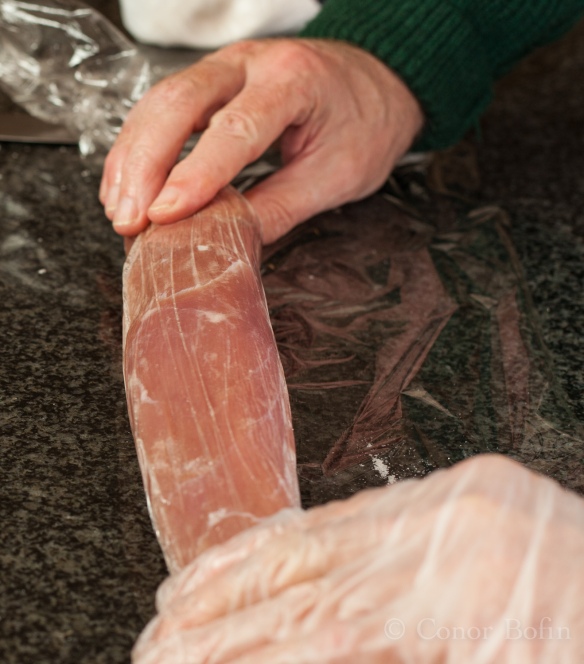
Wrap the tenderloin nice and tight. We don’t want much air in there.
On the day you plan to go into battle, or serve your guests, take the pork out of the fridge. Trim the kale of its stalks and any bits that are going to stick in one’s teeth.
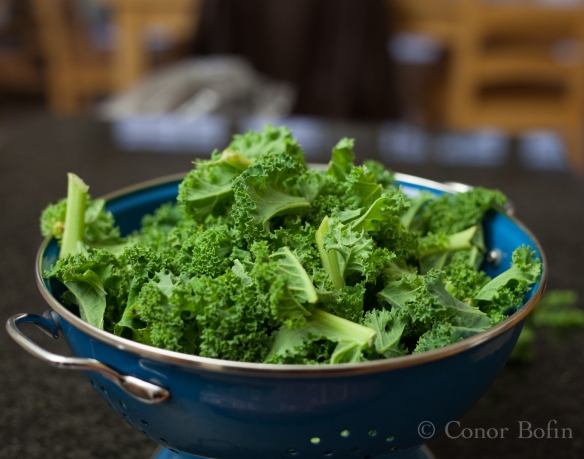
There is lots of trimming to do on the kale.
The kale adds a nice earthy flavour to this. It also helps keep the pork moist. When you have trimmed the kale, chop it up nice and small. Then fry it in a large pan with a bit of oil.
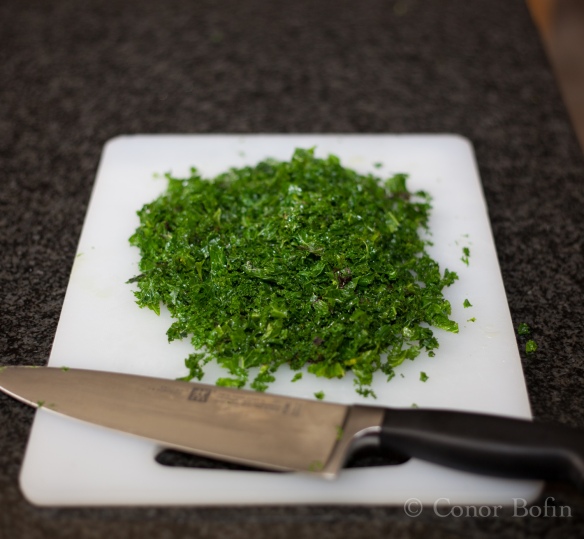
The cooked kale. It’s cooked when it reaches a high green colour.
Lay out the pastry. Make up the English mustard.
Side note on modern day mustard: Colman’s is the standard by which all powdered mustards are measured. They, like every other mustard manufacturer that occupies supermarket shelves have wimped it on their pre-made stuff. It is insipid and lacks any real kick. The powder makes up for that.
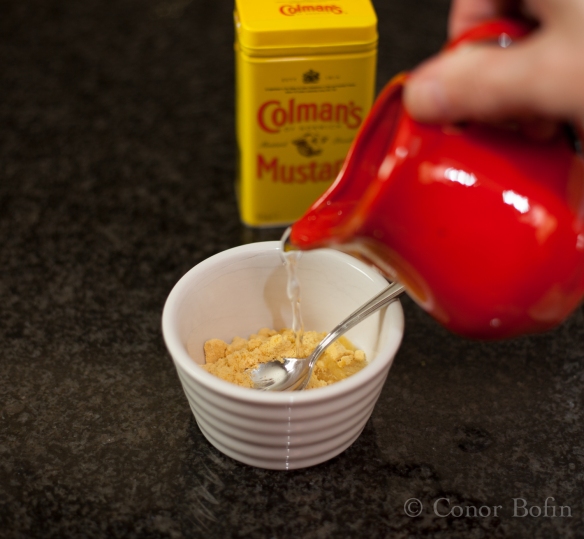
Make it nice and strong. It needs to be noticed in the heat of battle.
Smear the pastry sheets with plenty of mustard.

Straight down the middle will do for the mustard.
Cover the mustard with a layer of kale.
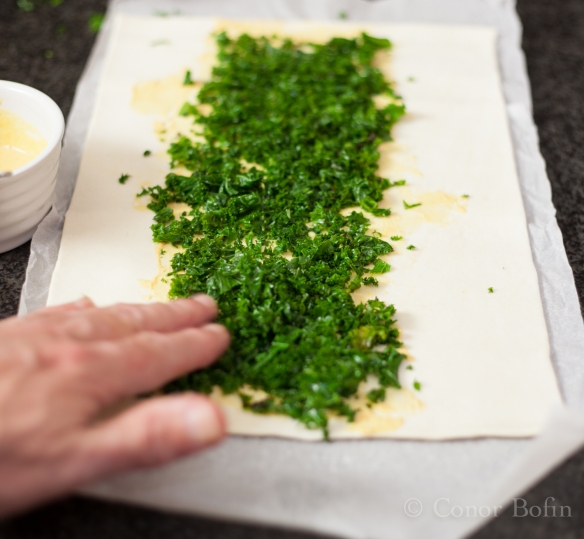
Make it a bit wider than the tenderloin. That way, it gets wrapped in kale.
Lay on the tenderloin and sprinkle more kale on top.

Wrap it carefully to get kale all over.
Seal the edges with egg wash and place them in a 200ºC (400ºF) oven for 20 minutes or so. I used a temperature probe to get the ham to a perfect 63ºC (145ºF).

Painted with egg and with the probe inserted.
The Wellingtons worked out really well and they were tasty to boot!
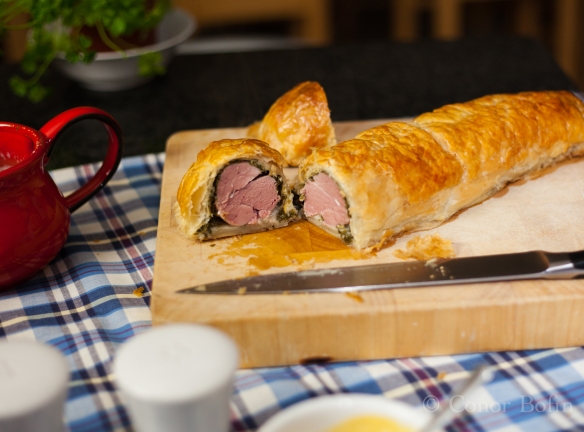
I might wrap them tighter the next time. Trust me, there will be a next time.
The finished dish was delicious with boiled potatoes and some traditional parsley sauce.

A big dollop of extra mustard for me please!
This was just as delicious served on a plate as it would have been back in the 19th century, being eaten, straight from the boot, by Wellington as he sat astride his charger. I can picture him munching this as he watched Napoleon, across the battle field of Waterloo, through his looking glass. What was Napoleon eating? Well that’s an entirely different story and for another day.


What a brilliant idea, love it. Do you think Arthur had his boots made from pig leather to keep the flavours pure? 🙂
LikeLike
Definitely not. They would have gone crispy in the heat of battle.
LikeLiked by 2 people
Good post and nice picture
LikeLike
Thanks Mukul,
I enjoyed cooking it and writing it.
LikeLiked by 1 person
Did you make that up? Love the kale.
LikeLike
Every word of it true Rosemary 😉
LikeLike
Ha, everything is swings and roundabouts, even kale. I am a bit disappointed you didn’t serve yours in an old gumboot for the sake of authenticity but it looks totally moreish.
LikeLiked by 1 person
The boot would have been fun. But, it probably would have ended up inedible. have you seen my wellingtons?
LikeLiked by 2 people
Well, you learn something new everyday! I love the history lesson. He would probably be the height of fashion now, eating from a boot.
Seriously, the wellington looks delicious. My lack of imagination means I have never veered from the traditional beef but this might tempt me.
LikeLike
I like the idea it was pork, but fear it might even have been a bit of old horse. This is, after all, the man who said of his *own* troops: “They may not frighten the enemy, but by God they frighten me!”. Not a man to turn his nose up at an early forerunner of the sausage roll…
LikeLike
The good Duke said a lot of distasteful things. He certainly didn’t hold his troops in any regard. However, he did know about a ham wellington!
LikeLiked by 1 person
Looks excellent!
(Did the less-wealthy make do with Pigs Foot Wellington? Or did they just raid the locals?…. 😉 )
LikeLike
Sadly, they had to go barefoot.
LikeLike
Fantastic, Conor. Great recipe and great story. Love the color of the kale and the combination of buttery pastry, spicy mustard, earthy kale and well… porky pork. As a tenderloin has a thin end and a thick end, you could wrap two of them ‘head to toe’ to get an even thickness.
LikeLike
That’s a good idea. I could also use the meat glue you sent me. It resides, unopened in my ‘blog room’.
LikeLiked by 1 person
This looks incredible delicious and being of German heritage a like the pork part of it. And I love the kale. It is one of my favorite vegetables, because it has so much flavor! Great recipe!
LikeLike
Thanks. It was delicious and I really will be doing it again. It has a lot going for it.
LikeLike
I am pretty sure it does. I think I have to try it soon. It would make my husband very happy 😉
LikeLiked by 1 person
I always learn so much from you! I have to say as I started to read, look at the recipe, all I could think about was stinky feet, because of the visual I got of the Field Marshal Arthur storing food inside his boots, but your photos quickly struck that from my mind. This looks wonderful! I’ve never made Wellington of any kind except mushroom for a Meatless Monday post. I’m gonna save this for later. I’ve gotta try it!
LikeLiked by 1 person
Hi Debbie, you are so kind in your comments. I am thinking i must do a traditional beef version very soon.
LikeLiked by 1 person
Yes, beef would probably be my favorite!
LikeLike
What a hoot you are Conor, love your Irish humour. I’m with you on the mustard thing, it must be Coleman’s, the French stuff is for wimps. I’ve had a good laugh to start the day, thanks
LikeLiked by 1 person
Happy to help where and when I can. Have a great one!
LikeLike
That’s a brilliant idea, I’m very tempted to make that myself. Did you rinse the fillets before wrapping them in pastry?
LikeLiked by 1 person
No MD. this was very straightforward. Very tasty too.
LikeLike
Fantastic – it really is very simple, which is often the making of excellent food 😉
LikeLiked by 1 person
I’m confused, Conor. The recipe I get. However, I can’t get out of the storage conundrum. Were his feet in the wellies along with the pork? Did the pastry not get horribly squashed? Or did he store the sausage rolls in his spare boots? I fear I can’t move on to the more culinary aspect without sorting the custodial.
LikeLiked by 1 person
You are such a pedant Sparling! Obviously enough, the good Duke was a man of some wealth and could afford to have extra wide sides on his wellies to facilitate the storing of a wellington per wellington, as it were. Very often, as I lie on my recliner, I think of what shape the world would be in today had Napoleon had the wit to have done likewise. We probably would not have the 1812 Overture as Pyotr Ilyich would have had to satisfy himself with a ditty for the victorious French rather than the triumphalist dirge that is the 1812.
That did not happen, as we know, and he met his Waterloo at Waterloo. Such are the great events on the world stagey that are the inspiration for my cookery. And you thought it all took place in the kitchen…
LikeLiked by 1 person
Well, it’s better than everything taking place in your head. You can’t eat fantasy.
LikeLiked by 1 person
No, but you can think you can.
LikeLiked by 1 person
And now I just want to do high kicks in a layered petticoats for some reason.
LikeLiked by 1 person
I don’t know why it strikes me as odd that kale would be a common ingredient back then. It seems so “new” to me! But of course for all I know the dinosaurs could have been munching on it way back when. Beautiful Wellington, Conor!
LikeLiked by 1 person
Dinosaurs and kale! Don’t have me tell you that little story!
LikeLiked by 1 person
I bet it’s a good one! 😉
LikeLiked by 1 person
What a super performance you made this ham wellington do. Thanks for the interesting historic reference. Being a history fan I love hearing such anecdotes. Did boots actually help tenderising the meat? 😉
LikeLiked by 1 person
I live in fear of anybody with a history bent taking this stuff seriously! But, to answer your question, of course they did.
LikeLike
Sometimes the line between history and myth is so thin… 😉
LikeLiked by 1 person
WOnderful story and delicious sounding recipe, Colin. Well, except for the storage. In a boot? Small wonder pork didn’t keep long. I no longer have a butcher to pester with questions. As is the case in so many of our neighborhoods, the butchers are getting on in years and there are no apprentices training to take over upon the elder’e retirement. Sadly, we’re losing almost all of them, one by one.
LikeLike
What a great post! An interesting use of kale. Wonder if I can get this past my husband without noticing…
LikeLike
Well you learn something new every day Conor, what a guy. A man willing to head into battle, his boots loaded with a pork snack or two, is alright by me and dervers all the titles he received. Love the recipe – cracking pairing with the parsley sauce too.
LikeLiked by 1 person
I did mean to put a winking face in the above. Reading it back, I feel I should point that out 😉
LikeLike
No need for the winking. Every word is true!
LikeLike
Thanks Phil. I do believe that it’s important to give the historical context for every recipe (where possible).
LikeLike